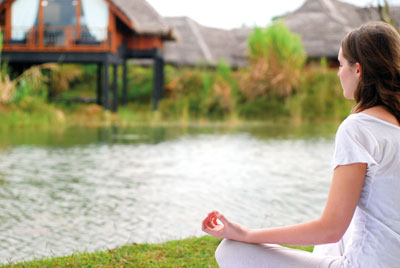Women’s contribution to SL’s tourism development
Tourism has demonstrated its potential for creating jobs and encouraging income-generating activities to benefit local communities in destination areas. However, less attention has been paid to the unequal ways in which the benefits of tourism are distributed between men and women, particularly in the developing world.
Women form the majority of the population in Sri Lanka with around 10.9 million females as opposed to 10.1 million males. Out of the almost 11 million-strong female population, 67 per cent is in the productive or active category of between 15 to 65 years of age.

A tourist in a meditation posture at Jetwing Vil Uyana. Jetwing Hotels encourages its female employees to reach for the stars, with many holding senior management positions including general manager-level.
However, out of the 8.5 million economically-active Sri Lankans, only 30 per cent constitute women, which mean that the majority of females are economically inactive.
This has directly resulted to build up a negative rate of growth of GDP over the last few years. The Department of Census and Statistics, in a report recently, identified that just over 5.3 million are the economically inactive female population in Sri Lanka.
The total contribution of travel and tourism sector to the world GDP was recorded as 10.2 per cent and 9.6 per cent of jobs worldwide. This means that this sector generates approximately 1 in 10 of all jobs across the world.
Globally, the tourism industry seems to be a particularly important sector for women in which 46 per cent of the workforce are women, as their percentages of employment in most countries are higher than in the workforce in general (nearly 40 per cent are women).
The number of women and their percentage of the workforce in tourism vary between countries – from 2 per cent up to over 80 per cent. Although there were few obvious regional trends it would appear that in those countries, where tourism is a more mature industry, women generally account for around 50 per cent of the workforce. Of the data available, it appears that there has been a broad increase in the participation of women for tourism industry at a global level.
This industry has also experienced a very low female participation. There are some significant reasons which affect to the less female participation in the tourism industry:
- Social and cultural situation, limited range of skills acquired by females lead to low skilled occupations in tourism industry.
- Lack of knowledge of handling of foreign languages, lack of professional knowledge required for the tourism industry, on occasion sees demand for low cost female labour. Multiple or dual work of the female, family responsibility and reproductive role, discrimination in the work environment specially in the tourism industry and no flexible hours allocated for female has resulted in less female participation in tourism.
In the tourism industry, the percentage of women who work in the industry is high, but their function is dominated by unskilled, low-paid jobs. Gender stereotyping and discrimination mean that women mainly tend to perform jobs such as cooking, cleaning and hospitality.
In the world we have many examples and experiences for female employment in tourism industry. Countries like Malaysia, Singapore, Maldives or Turkey have more employment of females in the tourism field because those sectors are more developed there. In order to support the development of tourism industry it is clear that females can contribute more. The industry provides formal and informal opportunities for females. It can significantly impact on poverty reduction in rural community.
There are many vacancies for females in this industry. Employment of more females in tourism can developed the industry as well as development of the economy. This can be done in many ways like increasing formal training, involving females at higher management level, scheduling flexible hours to perform their job at any time, allowing more autonomy in the integration of work and home obligation, establishing a pension scheme for tourism related occupations and increasing awareness of women’s important role in the economy.


